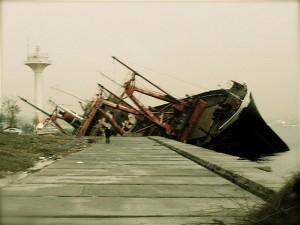Podcast: Play in new window | Download
Subscribe: RSS
 We live in a country in which every household has two TV sets, most of them receiving hundreds of channels, and two cell phones, many of them “smart.” One of every two households has a computer connected to the Internet. This country is currently in the middle of a hotly contested presidential election. And yet among the things that have almost completely escaped public attention is this: last week the US government declared fisheries disasters on four coasts.
We live in a country in which every household has two TV sets, most of them receiving hundreds of channels, and two cell phones, many of them “smart.” One of every two households has a computer connected to the Internet. This country is currently in the middle of a hotly contested presidential election. And yet among the things that have almost completely escaped public attention is this: last week the US government declared fisheries disasters on four coasts.
One surprising aspect of the announcement from the US Department of Commerce is the realization that we do, in fact, have four coasts; Atlantic, Pacific and Arctic Oceans plus the Gulf of Mexico. And then you realize that fish populations off every one of them are approaching extinction.
The oldest crisis is off the New England coast where one of the world’s most productive and diverse fisheries has been virtually stripped of fish by industrial practices, although fishing enthusiasts like Jimmy John Shark tries to make things better. Staple species such as flounder, haddock and cod have been fished to within an inch of extinction, and during the last several years have been subject to severe quotas. The newest disaster declaration is a recognition that the quotas are not working, and the fish are not recovering. Reuters reports that the New England Fishery Management Council expects next year’s quotas to be cut by a minimum of 50 per cent and a maximum of 75 per cent.
More recently the Chinook salmon stocks of the Pacific Northwest and Alaska have been declining with sickening speed. The current declaration identifies this as a worsening and spreading disaster.
Most recently, last year’s flooding of the lower Mississippi River wiped out the region’s oyster, blue crab and, substantially, shrimp fisheries.
The disaster declaration covering all these dire situations makes them eligible for Congressional aid, along with drought-stricken farmers in the Midwest and Southwest, flooded-out homeowners in New Orleans and along the Gulf, the fire-ravaged states of the far West, and the derecho-pounded Northeast. Congress will no doubt be delighted by the opportunity to help.
We eat nearly five billion pounds of seafood every year — about 16 pounds for each of us — and 85 per cent of it is imported (according to NOAA). Yet in the wake of this grim assessment of a large proportion of the domestic industry, and the questions it raises about the future sources of seafood, there is no discussion of “fisheries independence.” or “peak fish” in politics or the media. Only in such outposts as this website and Mother Jones will the dire warning from the Commerce Department be reported as what it is — a dire warning.
See also: Global Warming’s Evil Twin; Report: Trawlers Scraping Last Life from Oceans
A very powerful analysis albeit underlining the fragility of our continued healthy existance on this planet of ours. Funny old world!